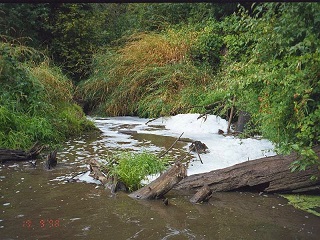From Guest Blogger Bobbi Petersen: Water Pollution and Household Cleaners

Keeping your home clean is one of the most obvious signs that you care about your surroundings. But what do you do when the products designed to purify your environment are contaminating it?
Common household cleaning products may contain ingredients known to be carcinogens. The products may cause allergies, burns or poisoning. Look out for words on labels such as “danger,” “warning,” or “caution,” which indicate that the products have varying levels of toxicity. Many products don’t list all the ingredients used, so be mindful of the toxicity in your cleaning supplies.
In the Waterways
Once cleaning products make it down our drains, they become a part of the sewage and water waste that’s treated and routed into our rivers, lakes and other waterways. Most ingredients break down during or after treatment and are not a major concern, but that’s not true for all ingredients in commercial cleaning products.
Phosphorus, nitrogen and ammonia are a few dangerous chemicals that — in large quantities — and can’t be removed by the sewage treatment process. They are used in common household cleaners and also as fertilizer on farms. The chemicals build up in fresh waterways and can affect the growth cycles of plants by introducing excessive nourishment and overgrowth of plants.
Too many plants deplete the oxygen supply in the water and eventually kill fish and other living things. Some marine life scientists believe the pollution to be a global epidemic that must be abated. Many states in the United States have banned phosphates, but some product brands still contain them.
A survey by the Environmental Protection Agency found that 40 percent of rivers and 45 percent of lakes in the United States are too polluted for fishing, swimming or aquatic life. One of the most commonly found contaminants is phosphate. Laundry detergent and other cleaning products contain it. The amount Americans use each year is astonishing — Americans use about 9.3 billion pounds of detergent each year.
Homemade Cleaners
Although there is a potential hazard of common cleaners polluting our water supply, there is good news. You can keep your home clean and help safeguard the environment by making your own products. Simple ingredients will handle most of your typical, everyday cleaning needs. For example, many cleaning aids can be made with soap, water, baking soda, vinegar or lemon juice.
Sometimes a more intense cleaner is in order and an all-natural solution may still be an option. For example, if you need to kill and clean mold, try one of these natural recipes.
- Spray vinegar on the area you want to treat, leave it for several hours and them scrub the mold away.
- Mix a cup of water and a teaspoon on tea tree oil in a bottle. Spray the area, leave it for an hour and then wipe it away.
- Mix 1 part hydrogen peroxide with 2 parts water. Spray the affected area, leave it for about 10 minutes and scrub it away.
Alternative Commercial Cleaners
Convenience is a major benefit to buying premade cleaners. Store-bought cleaners can be a good option as long as you pay attention the ingredients. Look for mentions of how long it takes a product to biodegrade. Also, look for products that are plant-based or don’t contain phosphates or solvents. “Eco-friendly” and “all-natural” are vague terms that don’t carry specific meaning.
Products that we don’t normally consider to be pollutants could be harming the environment. Cleaners and other chemicals we use to keep our homes safe and clean could be making the homes of wildlife unsafe. Common household products affect our water in various ways, some more obvious than others. A simple way everyone can help minimize water pollution is to not dispose of hazardous waste products through the septic system. Take them to a hazardous waste collection center in your local area.
